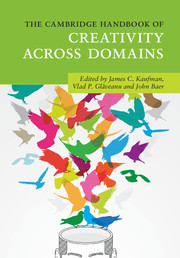Book contents
- The Cambridge Handbook of Creativity Across Domains
- The Cambridge Handbook of Creativity Across Domains
- Copyright page
- Dedication
- Contents
- Figures
- Tables
- Contributors
- Acknowledgments
- Part I Creativity and Domain
- Part II Creativity in the Traditional Arts
- Part III Creativity in the Sciences
- Part IV Creativity in Business
- Part V Newer Domains for Creativity Research
- Part VI Creativity in Everyday Life
- 29 Creativity in the Domain of Emotions
- 30 Creativity in Teaching
- 31 Culture and Creativity
- 32 The Benefits of Creativity in Therapy
- 33 Creativity in the Domain of Play
- 34 Creativity in Craft
- Part VII Conclusion
- Index
- References
30 - Creativity in Teaching
from Part VI - Creativity in Everyday Life
Published online by Cambridge University Press: 15 September 2017
- The Cambridge Handbook of Creativity Across Domains
- The Cambridge Handbook of Creativity Across Domains
- Copyright page
- Dedication
- Contents
- Figures
- Tables
- Contributors
- Acknowledgments
- Part I Creativity and Domain
- Part II Creativity in the Traditional Arts
- Part III Creativity in the Sciences
- Part IV Creativity in Business
- Part V Newer Domains for Creativity Research
- Part VI Creativity in Everyday Life
- 29 Creativity in the Domain of Emotions
- 30 Creativity in Teaching
- 31 Culture and Creativity
- 32 The Benefits of Creativity in Therapy
- 33 Creativity in the Domain of Play
- 34 Creativity in Craft
- Part VII Conclusion
- Index
- References
Summary
Creative teaching, like all forms of teaching, is a polymorphous act. It can take multiple forms and have different pedagogical aims. The purpose of this chapter is to describe creativity in the domain of teaching and clarify three forms of creative teaching: teaching about creativity, teaching for creativity, and teaching with creativity. The chapter will describe each of these types of creative teaching, including their different aims, previous work on each type, and the knowledge base necessary for each type of creative teaching. Directions for future research will also be discussed.
Information
- Type
- Chapter
- Information
- The Cambridge Handbook of Creativity across Domains , pp. 549 - 564Publisher: Cambridge University PressPrint publication year: 2017
References
Accessibility standard: Unknown
Why this information is here
This section outlines the accessibility features of this content - including support for screen readers, full keyboard navigation and high-contrast display options. This may not be relevant for you.Accessibility Information
- 37
- Cited by
